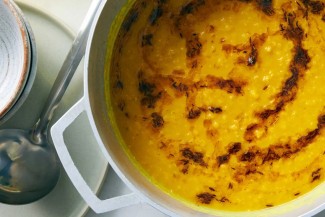Everyday Dal

The warming, soothing and downright healing effects of dal are well known throughout South Asia and its diaspora. This is an everyday dish for a good reason: It’s simple to make but tastes complex, and the flavor only deepens over time. There are countless ways to make dal; this version requires just 10 minutes and five ingredients (not including salt), all serving important purposes: The lentils cook quickly, the turmeric lends an earthy wholesomeness and the rich chhonk, or tempering, made by sizzling spices with ghee, brings instant depth. To gussy it up, try adding a packet of frozen spinach, or stirring minced garlic into the chhonk. If you’re tempted to use ground cumin instead of cumin seeds, resist! The seeds have a distinctly smokier flavor and add a pleasant texture to the dal.
1 cup red lentils (also known as red split lentils or masoor dal)
1 teaspoon ground turmeric
Salt
3 tablespoons ghee
2 teaspoons cumin seeds
⅛ to ¼ teaspoon ground red chile
⅛t easpoon asafetida (optional but extremely good, see Tip)
Rice or roti, for serving
Combine the lentils (no need to rinse them) with the turmeric, 1 teaspoon salt and 3 cups of water in a medium saucepan. If you like your dal a little soupier, add an extra cup of water here. Bring to a boil over high heat. Reduce the heat to a simmer, cover and cook for 5 to 8 minutes, until the lentils resemble a loose porridge. If the lentils are too thick, add a little hot water.
In a small pan or pot, melt the ghee over medium heat and add the cumin seeds. Let them cook until they are aromatic and a darker shade of brown, about 1 minute. Stir in the red chile powder and asafetida, let them toast for a few seconds until fragrant (the asafetida will give off a garlic-esque scent), then remove from the heat.
Taste the lentils and add more salt if desired. Pour the hot ghee over the lentils — you can either stir to combine or leave it be, for a dramatic presentation — and serve with rice or roti.
TIP
Asafetida is a tree resin used commonly as a seasoning in South Asian cuisines. It has a wonderfully potent, sort of allium-esque flavor that adds depth to many dishes. It can be ordered online or found in South Asian grocery stores, and it is worth going out of your way to purchase — it really makes this dish sing. An imperfect but somewhat suitable substitute is garlic powder.
Nutritional analysis per serving (4 servings)
348 calories; 10 grams fat; 6 grams saturated fat; 0 grams trans fat; 3 grams monounsaturated fat; 1 gram polyunsaturated fat; 51 grams carbohydrates; 5 grams dietary fiber; 1 gram sugars; 14 grams protein; 195 milligrams sodium